Exploring Thin Backend

Introduction
If you're familiar with web development, you've probably heard of the term "backend". It's the part of the website that the user doesn't see, where all the code and logic that drives the website is stored. Recently, there has been a lot of buzz about "thin backend" - a new approach to building backend systems. In this blog post, we'll explore what a thin backend is, why it was created, what its characteristics and strengths are, and how to use it, even if you're a beginner.
What is a Thin Backend?
A thin backend is a new approach to building backend systems that is designed to be lightweight and highly efficient. It was created in response to the growing demand for more scalable and flexible backend systems that can handle the complex needs of modern web applications. A thin backend typically consists of a small set of core services that are highly optimized for speed and performance, and can be easily combined with other services to create a complete backend system.
Traditionally, backend systems have been built using monolithic architectures, which means that all the code and logic is combined into a single, large application. While this approach can work well for smaller projects, it can become unwieldy and difficult to maintain as the project grows in size and complexity.
A thin backend, on the other hand, is designed to be highly modular, with each service focused on a specific task or function. This makes it much easier to add, remove, or modify services as needed, without affecting the rest of the system.
Characteristics and Strengths of Thin Backend
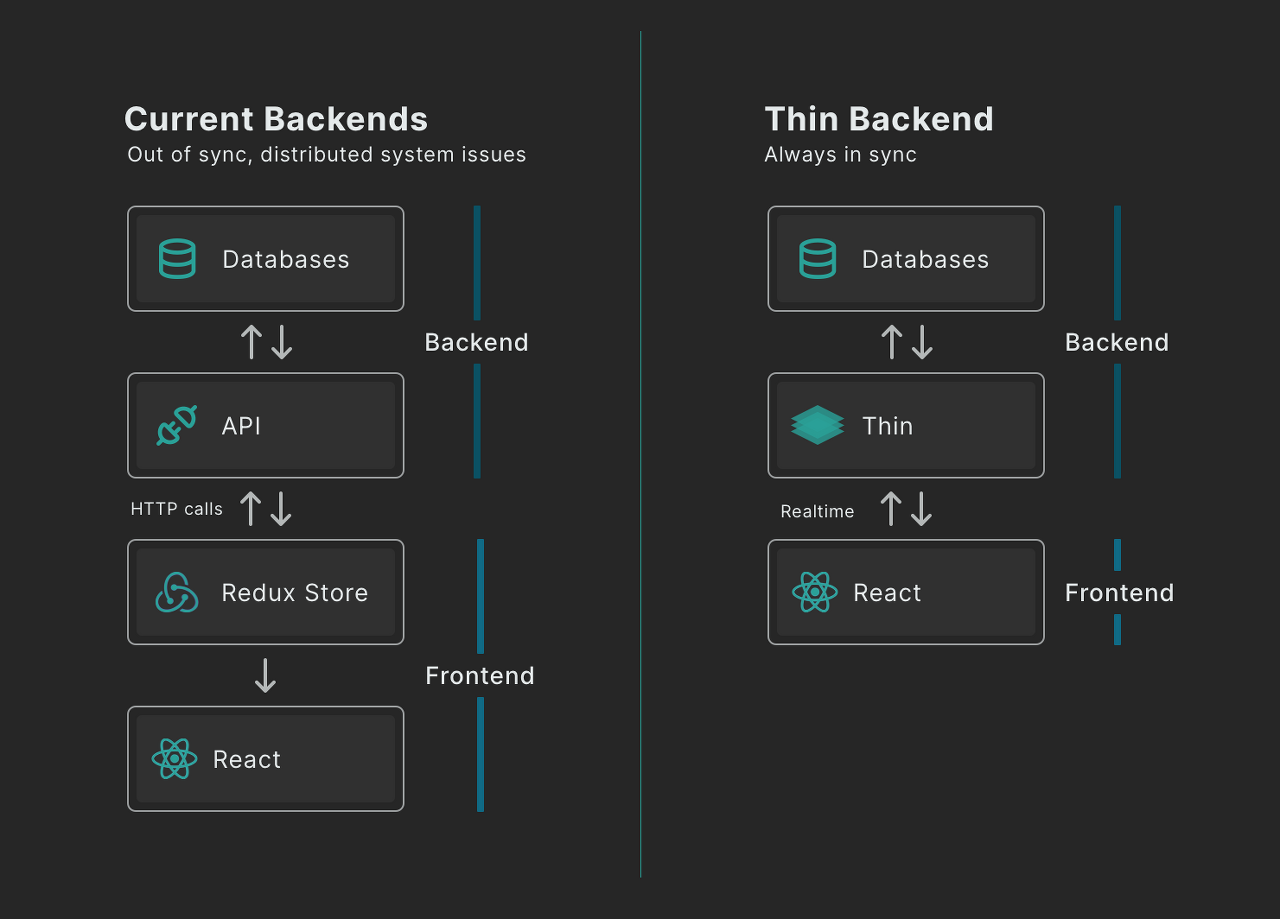
One of the biggest advantages of a thin backend is its simplicity. Because it's designed to be lightweight and highly efficient, it's much easier to build, maintain, and scale than traditional backend systems. Thin backends are also highly modular, which means that you can easily add or remove services as needed, without affecting the rest of the system. This makes it much easier to adapt to changing requirements and to scale the system as traffic increases.
Another strength of a thin backend is its performance. Because it's highly optimized for speed and efficiency, it can handle large amounts of traffic with ease, without sacrificing performance. Additionally, because it's so lightweight, it can run on smaller, less expensive servers, which can save you a lot of money in hosting costs.
Thin backends are also highly flexible, which means that you can easily integrate them with other services and systems. This makes it much easier to build complex applications that require multiple backend systems to work together.
Finally, because thin backends are built using open-source frameworks, they are highly customizable. This means that you can modify the code to better suit your specific needs, or even create your own custom services to add to the system.
Advantages of Thin Backend

Apart from the main strengths of thin backend mentioned above, there are several other advantages to using this approach. One of the biggest is that thin backends are highly scalable. Because they are designed to be modular and highly efficient, they can handle large amounts of traffic with ease, and can be easily scaled up or down as needed.
Another advantage of thin backends is that they are highly resilient. Because each service is focused on a specific task or function, the system as a whole is much more resilient to failure. If one service fails, it doesn't necessarily mean that the entire system will fail, which is a huge advantage when it comes to maintaining uptime and ensuring that your application is always available.
Thin backends are also highly secure. Because they are built using open-source frameworks, they are constantly being updated and improved to address any security vulnerabilities. This means that you can be confident that your backend system is secure and that your data is safe.
How to Use Thin Backend If you're interested in using a thin backend, the good news is that it's relatively easy to get started, even if you're a beginner. There are a number of open-source thin backend frameworks available, such as Express.js and Flask, that provide a simple and intuitive way to build backend systems. These frameworks typically provide a set of core services, such as routing and middleware, that you can use to build your own backend system.
To start building your own thin backend, you'll need to have some basic knowledge of programming languages such as JavaScript or Python. You'll also need to be familiar with concepts such as APIs and HTTP requests. Once you have these basics down, you can start building your own backend system using one of the available frameworks.
Simple usage This is a quick start that appears when you sign up for a thin backend, it's very simple.
- checkout project template
npx degit digitallyinduced/thin-typescript-react-starter thin-project
- Switch Directory & Install Dependencies & Add Typescript Definitions
cd thin-project && npm install && npm install --save-dev "https://thin.dev/types/6cca19dc-dc50-48ad-aad4-c5286134d9d0/cappulbkdeIHkbOOTUJoxqAakuLZBrzw"
- Configure the Backend Url in .env
echo 'BACKEND_URL=https://test-161.thinbackend.app' > .env
- Start Server
npm run dev
-
Now You can see your app!
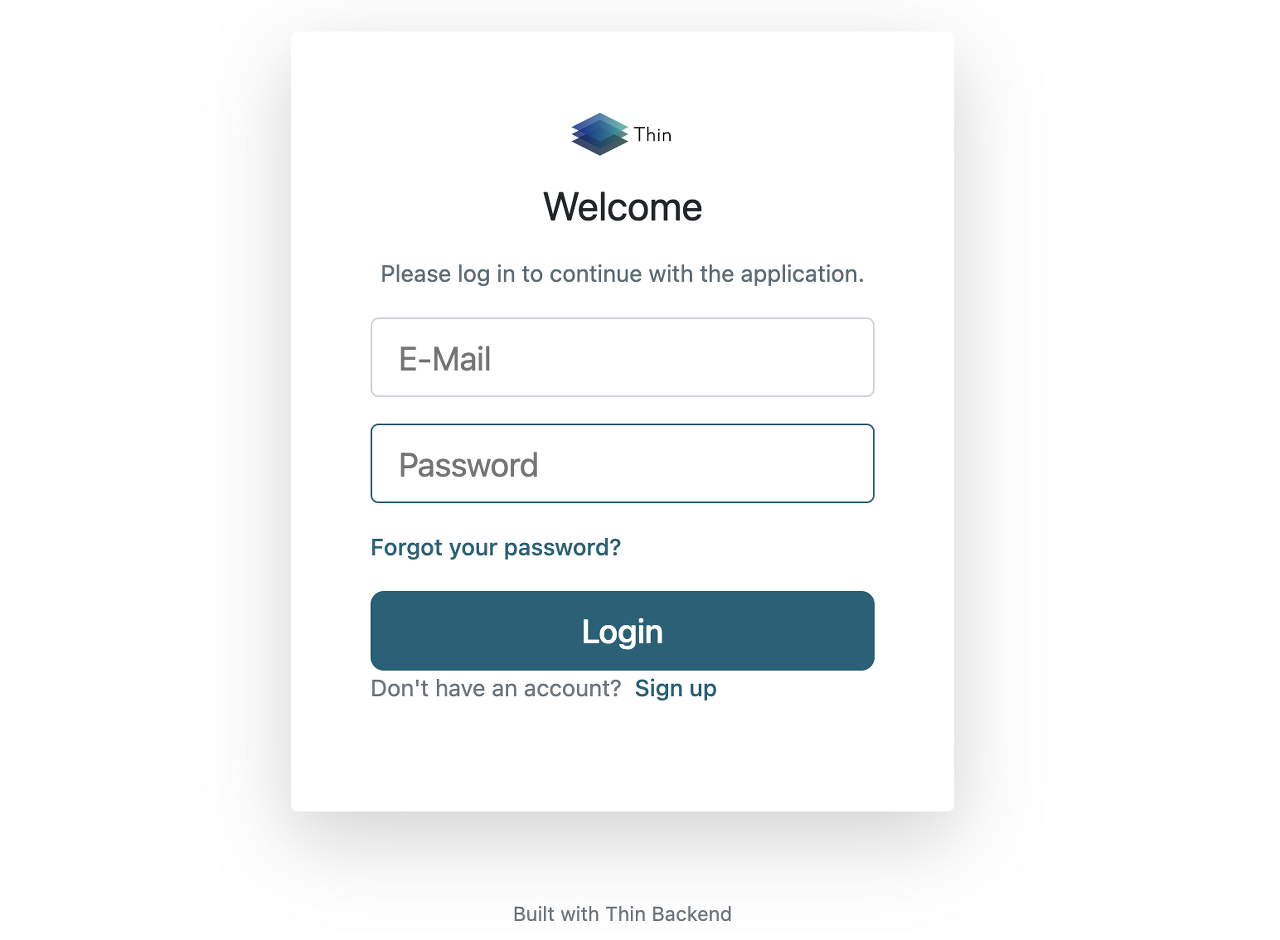
-
By default, you can check the database where the user table is created, and you can even register as a member by clicking the sign up button above, and you can also check the users added to the database in real time. Login, signup, and logout have already been developed.
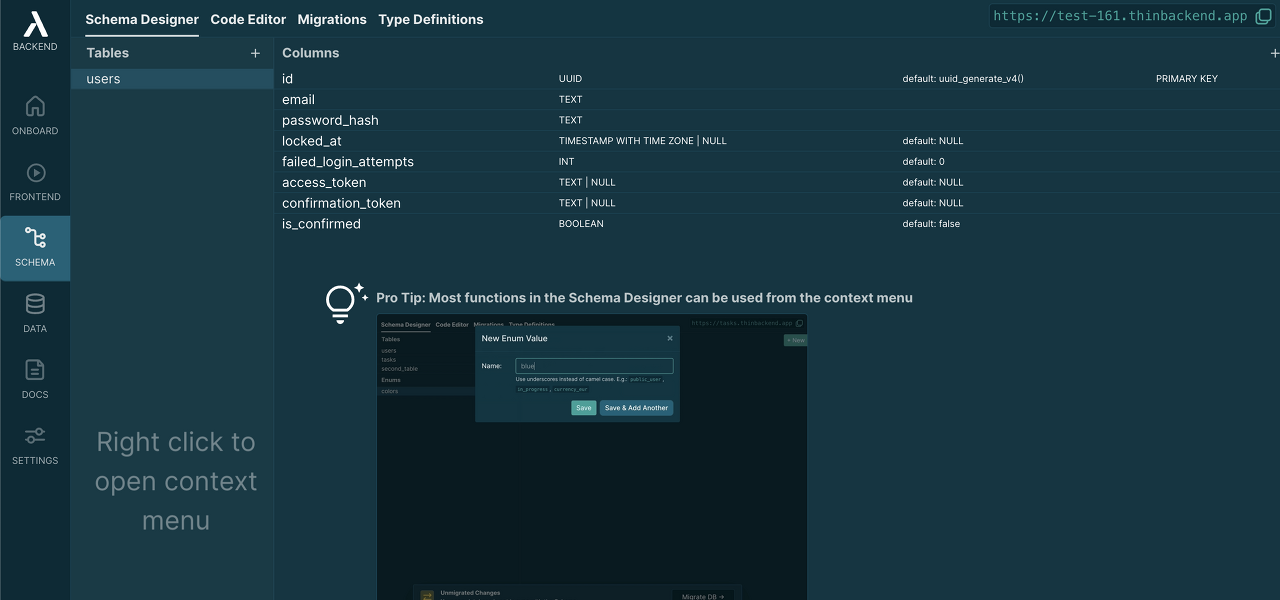
-
The project structure is simple. Through thin-backend-react library, put ThinBackend as the top tag and put the tags to be rendered as children. At this time, if requireLogin attribute is set to true in the ThinBackend tag, you need to login using the login format provided by ThinBackend to see the tags defined as children in order to view the tags set as children.
And through the useCurrentUser function provided by the thin-backend-react library, the current user information can be retrieved and used. Logout is also provided by the thin-backend library. In this way, the login, logout, register function, which was cumbersome when starting a project, can be implemented very simply. Now you just need to implement the contents of the actual web site right away!
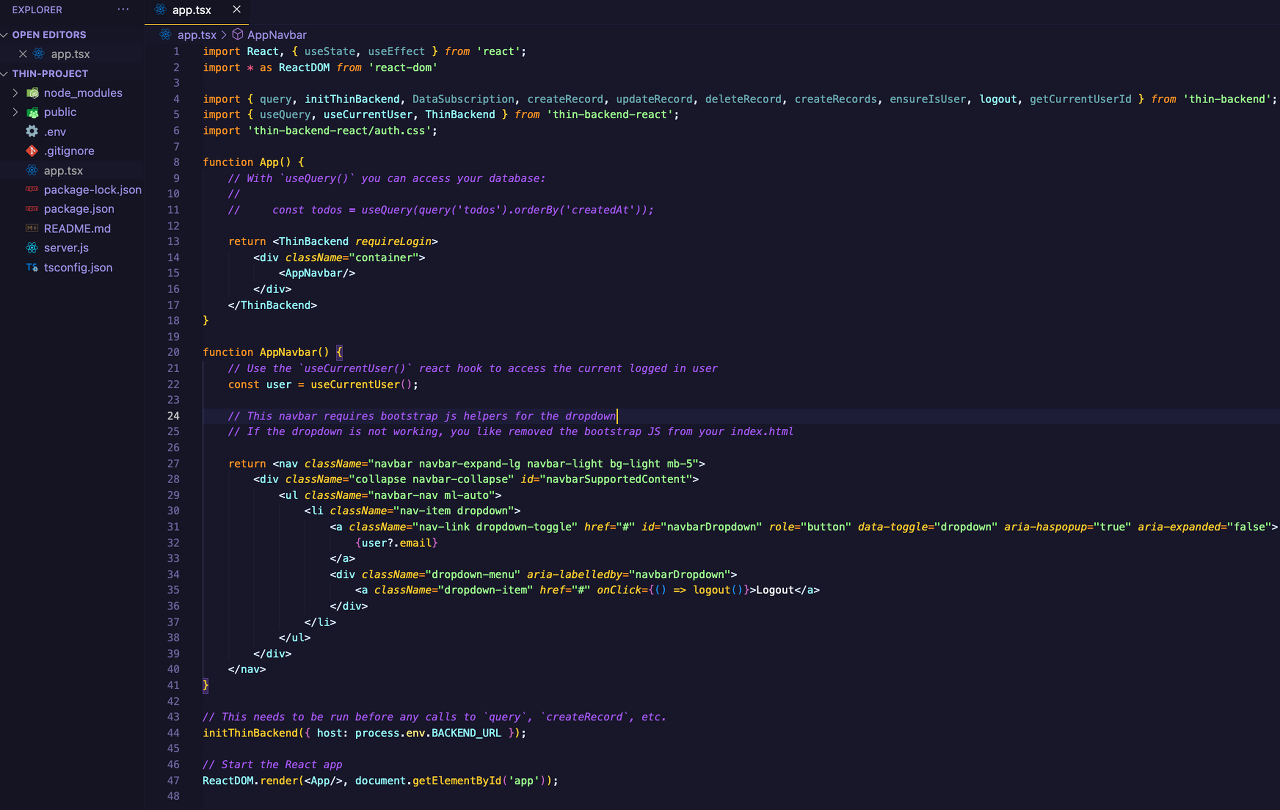
Common Use Cases for Thin Backend
There are several common use cases for thin backend, which make it a popular choice for developers. One example is for building microservices. Microservices are small, independent services that work together to form a larger application. Because each service is focused on a specific task or function, a thin backend is the perfect architecture for building microservices.
Another common use case for thin backend is for building APIs. APIs are a way for different applications to communicate with each other. Because a thin backend is highly modular and flexible, it's a great choice for building APIs that can work with a wide variety of different applications.
Thin backend is also a popular choice for building real-time applications, such as chat applications or real-time gaming applications. Because it's highly optimized for speed and performance, it can handle the large amounts of data that are typically involved in real-time applications.
Thin Backend Has Some Limitations
 One of the main limitations is that it may not be suitable for larger, more complex websites. Thin Backend is designed to be lightweight and efficient, which can make it an excellent choice for small to medium-sized websites. However, larger websites may require more complex functionality and may benefit from a traditional backend with a database.
One of the main limitations is that it may not be suitable for larger, more complex websites. Thin Backend is designed to be lightweight and efficient, which can make it an excellent choice for small to medium-sized websites. However, larger websites may require more complex functionality and may benefit from a traditional backend with a database.
Another limitation of Thin Backend is that it may require more development time and expertise than other similar technologies. Because Thin Backend does not use a database, creating custom modules and integrating them into a website may require more coding expertise than other similar technologies. Additionally, because Thin Backend is a relatively new technology, there may be fewer resources and support available compared to more established technologies.
Another limitation of Thin Backend is that it may not be compatible with all hosting environments. Thin Backend typically requires a web server with certain configurations to function properly, which may limit the choice of hosting providers for a website built with Thin Backend.
Conclusion
In conclusion, despite these limitations, Thin Backend remains an excellent choice for many web development projects, particularly those that require a lightweight, fast-loading website with a high degree of customization and security.
a thin backend is a new approach to building backend systems that is lightweight, modular, and highly efficient. It's designed to be easy to build, maintain, and scale, and can handle large amounts of traffic with ease. If you're interested in building your own thin backend, there are a number of open-source frameworks available that provide a simple and intuitive way to get started. So why not give it a try and see for yourself what the best strengths of the thin backend can do for your web application?
As more and more web applications are developed, the need for scalable backend systems that can handle large amounts of traffic becomes increasingly important. By adopting a thin backend approach, you can build a system that is efficient, easy to maintain, and highly adaptable to changing requirements. So if you're looking for a new approach to building backend systems, why not give a thin backend a try? You may be surprised at just how effective it can be.
Overall, thin backend is a great choice for developers looking for a lightweight, modular, and scalable backend system that can handle large amounts of traffic with ease. Its simplicity, flexibility, and performance make it a popular choice for many developers, and its open-source nature means that it's constantly being improved and updated to address any issues or vulnerabilities. So if you're looking to build a new backend system, consider giving a thin backend a try - you may be surprised at just how effective it can be.

 Are you tired of slow and inefficient data storage solutions? Look no further than Dragonfly, the in-memory data store that is taking the tech world by storm. With lightning-fast speed and compatibility with existing Redis and Memcached APIs, Dragonfly is the perfect solution for anyone looking to improve their data storage capabilities.
Are you tired of slow and inefficient data storage solutions? Look no further than Dragonfly, the in-memory data store that is taking the tech world by storm. With lightning-fast speed and compatibility with existing Redis and Memcached APIs, Dragonfly is the perfect solution for anyone looking to improve their data storage capabilities.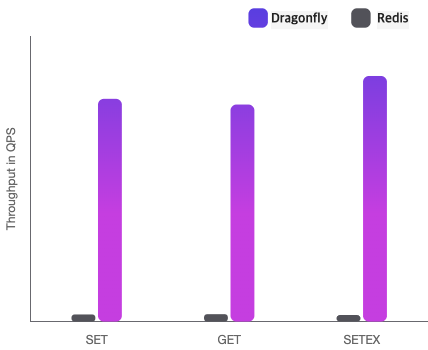 So how does Dragonfly stack up against other popular data storage solutions like Redis and Memcached? In terms of speed and performance, Dragonfly is the clear winner. Its in-memory architecture allows for lightning-fast data access and retrieval, while Redis and Memcached rely on disk-based storage that can slow things down.
So how does Dragonfly stack up against other popular data storage solutions like Redis and Memcached? In terms of speed and performance, Dragonfly is the clear winner. Its in-memory architecture allows for lightning-fast data access and retrieval, while Redis and Memcached rely on disk-based storage that can slow things down.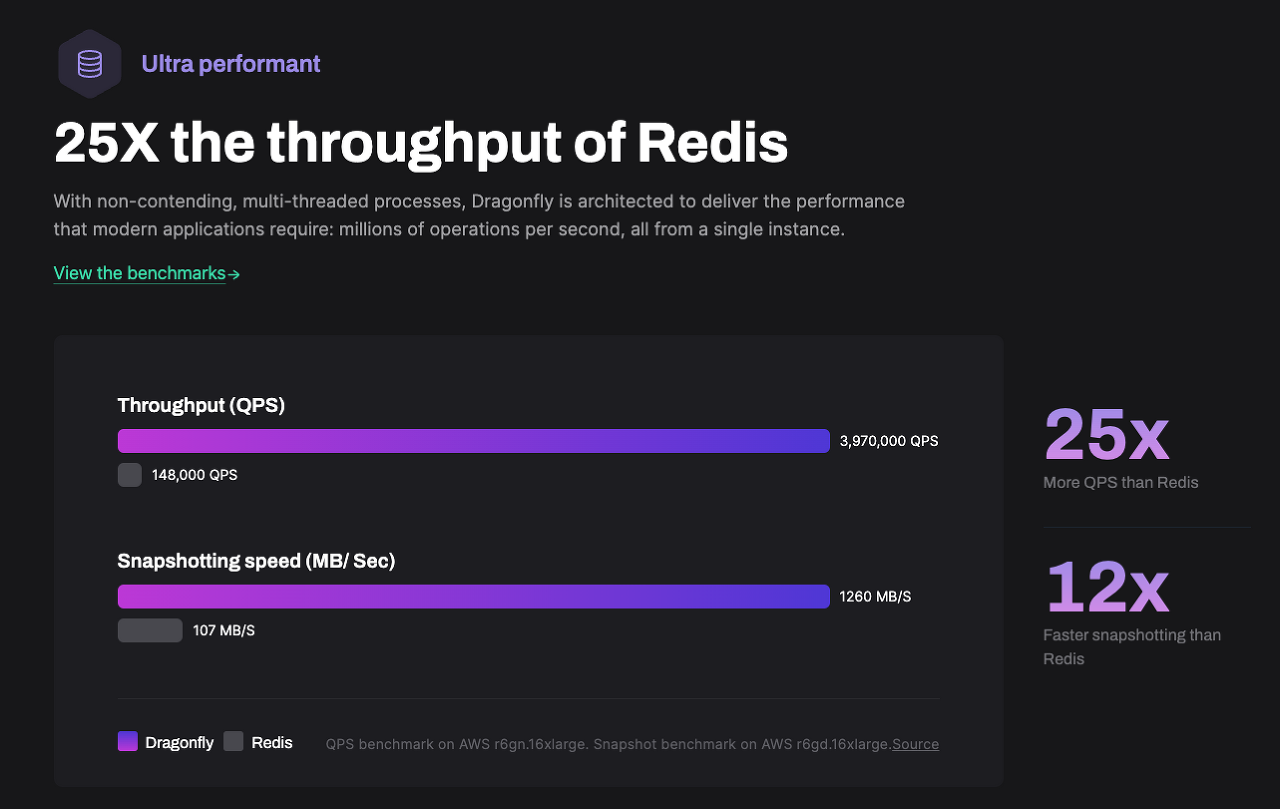 While Dragonfly's speed and performance are impressive, it can be more complex to set up and configure than Redis and Memcached. However, with a little bit of effort, you can ensure that your Dragonfly instance is optimized for maximum efficiency.
While Dragonfly's speed and performance are impressive, it can be more complex to set up and configure than Redis and Memcached. However, with a little bit of effort, you can ensure that your Dragonfly instance is optimized for maximum efficiency.